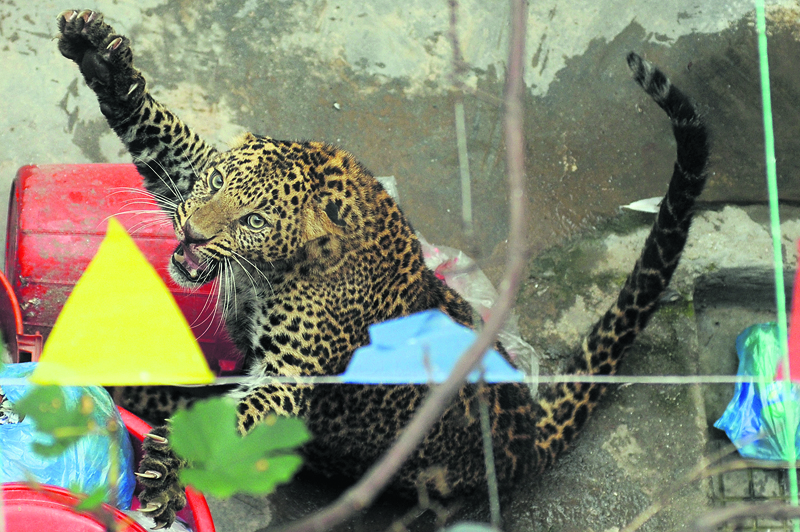
OR
Leopards increasingly enter human settlements of Kathmandu Valley
Published On: February 9, 2017 12:30 AM NPT By: Ram Saran Tamang

Decrease in leopards' prey to blame for the situation: Expert
KATHMANDU, Feb 9: A leopard was spotted in Paga, a residential area of Kirtipur, early on Wednesday morning. The wild cat, obviously terrified, had barged into a house of one of the locals to hide from humans.
As soon as the news circulated in the locality, a huge number of people gathered around the area to observe the leopard. Everyone from children, youths to elderly people gathered around the house of Shree Krishna Shrestha, where the leopard was hiding. The fear and excitement were clearly noticeable on the faces of the keen onlookers.
Although the leopard was spotted at 6 am in the morning, a team of police and members of the Central Zoo and District Forest Office reached the incident site only after three hours, according to the locals. It had reportedly entered the house on Tuesday night. The team then readied themselves to control the leopard with tranquilizer.
However, the leopard continued to stay in hiding for seven hours. The patience finally paid off at 1 pm in the afternoon as the leopard was taken under control without any harm either to the people or itself. It was then taken away and later freed into its habitat.
The incident had created chaos among the locals. However, this incident is not the first of its kind in Kathmandu Valley. Leopards have been entering human settlements of the Valley frequently of late.
Last year on September 24, a leopard had entered Lubhu of Lalitpur and barged inside a house of a local. Likewise, a leopard strayed into a house near Ganesthan Temple of Kuleshwar on June 1, while a similar incident was noted on January 9 last year in New Baneshwar, the heart of the capital. Many of such incidents also go unreported.
“Leopards enter human settlements for various reasons, mostly in search of its prey,” explained Laxman Paudel, ecologist at the Department of National Parks and Wildlife Conservation (DNPWC).
“They are increasingly facing shortage of prey in their habitat. So, they enter human settlements to prey on dogs and other animals, which are in large numbers in the residential areas of the Valley.”
According to DNPWC, forest areas surrounding the valley have increased and even the number of leopards also may have increased. However, their preys have not increased accordingly, causing leopards to frequently visit human settlements in search of their prey.
“As leopards are active mostly during night, they sometimes wander off into human settlements unintentionally,” said ecologist Paudel. “By the time they want to return back to their habitat, it would already be morning. Then noises from locals leave them no choice but to hide inside house.”
As increase in number of leopards entering human settlements put life of humans and wildlife at risk, experts have stressed on the need to study leopards' behavior and pay attention to the number of their prey. They also suggested that the number of stray dogs in the valley should be checked to minimize such incidents.
According to DNPWC, habitats of leopards around the Valley include forests of Shivapuri, Budhanilkantha, Godavari, Tokha, among others. The department has urged the public not to make noise to ensure that leopards do not get scared and aggressive during such incidents. They also requested the public to inform nearby police post at the earliest in case of such incidents.
You May Like This

1,255 more test positive for COVID-19, 25 patients die in past 24 hours
KATHMANDU, Nov 29: As many as 1,255 more people were diagnosed with the novel coronavirus disease (COVID-19) on Sunday, the... Read More...

All hospitals in Kathmandu together can hold only 195 COVID-19 patients in ICUs and 88 on ventilators
54 percent of ICU beds and 47 percent ventilators are already occupied ... Read More...

Public holiday in Kathmandu Valley tomorrow
KATHMANDU, July 28: The government has announced public holiday in Kathmandu Valley for Friday on the occasion of Bhoto Jatra.... Read More...


Just In
- 19 hydropower projects to be showcased at investment summit
- Global oil and gold prices surge as Israel retaliates against Iran
- Sajha Yatayat cancels CEO appointment process for lack of candidates
- Govt padlocks Nepal Scouts’ property illegally occupied by NC lawmaker Deepak Khadka
- FWEAN meets with President Paudel to solicit support for women entrepreneurship
- Koshi provincial assembly passes resolution motion calling for special session by majority votes
- Court extends detention of Dipesh Pun after his failure to submit bail amount
- G Motors unveils Skywell Premium Luxury EV SUV with 620 km range















Leave A Comment